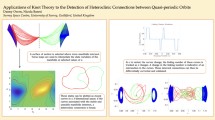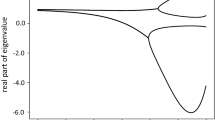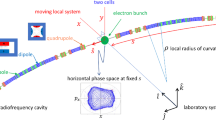Abstract
Orbit-orbit and spin-orbit gravitational resonances are analyzed using the model of a rigid pendulum subject to both a time-dependent periodic torque and a constant applied torque. First, a descriptive model of passage through resonance is developed from an examination of the polynomial equation that determines the extremes of the momentum variable. From this study, a probability estimate for capture into libration is derived. Second, a lowest order solution is constructed and compared with the solution obtained from numerical integration. The steps necessary to systematically improve this solution are also discussed. Finally, the effect of a dissipative term in the pendulum equation is analyzed.
Similar content being viewed by others
References
Abramowitz, M. and Stegan, I. I.: 1965,Handbook Mathematical Tables, Dover, New York, pp. 587–600.
Allan, R. R.: 1967, ‘Resonance Effects Due to the Longitude Dependence of the Gravitational Field of a Rotating Primary’,Planetary Space Sci. 15, 53.
Allan, R. R.: 1969, ‘Evolution of Mimas-Tethys Commensurability’,Astron. J. 174, 497.
Best, R. W.: 1968, ‘On the Motion of Charged Particles in a Slightly Damped Sinusoidal Potential Wave’,Physics 40, 182.
Born, M.: 1945,Atomic Physics, Blackie & Son, London, 3rd ed., pp. 45–60.
Cole, Julian D.: 1968,Perturbation Methods in Applied Mathematics, Blaisdell, Mass.
Colombo, G.: 1965, ‘On the Rotational Period of the Planet Mercury’,Nature 208, 575.
Colombo, G. and Shapiro, I. I.: 1966, ‘Rotation of the Planet Mercury’,Astrophys. J. 145, 891.
Contopoulos, G.: 1966, ‘Adiabatic Invariants and the “Third” Integral’,J. Math. Phys. 7, 5, 788.
Counselman, C. C.: 1969, ‘Spin-orbit Resonance of Mercury’, Ph.D. Thesis, MIT.
Corben, H. C. and Stehle, P.: 1966,Classical Mechanics, John Wiley, New York, pp. 183–191.
Gardner, C. S.: 1959, ‘Adiabatic Invariants of Periodic Classical Systems’,Phys. Rev. 115, 4, 791.
Gebman, Jean Rene: 1974, ‘Perturbation Analysis of the Flat-Spin Recovery of a Dual-Spin Spacecraft’, Ph. D. Thesis, UCLA.
Goldreich, P.: 1965, ‘An Explanation of the Frequent Occurrence of Commensurable Mean Motions in the Solar System’,Monthly Notices Roy. Astron. Soc. 130, 159.
Goldreich, P. and Peale, S. J.: 1966, ‘Spin-Orbit Coupling in the Solar System’,Astron. J. 71, 425.
Goldreich, P. and Peale, S. J.: 1967, Spin-orbit Coupling in the Solar System II: The Resonant Rotation of Venus’,Astron. J. 72, 662.
Goldreich, P. and Soter, S.: 1966, ‘Q in the Solar System’,Icarus 5, 375.
Gradshteyn, I. and Ryzhik, I. M.: 1965,Table of Integrals, Series and Products, Academic Press, New York, 4th ed., pp. 157–904.
Greenberg, R. J., Counselman III, C. C. and Shapiro, I. I.: 1972, ‘Orbit-orbit Resonance Capture in the Solar System’,Science 178, 747.
Kevorkian, J.: 1971, ‘Passage Through Resonance for a One-Dimensional Oscillator with Slowly Varying Frequency’,SIAM J. Appl. Math. 20, 3, 364.
Sinclair, A. T.: 1972, ‘On the Origin of the Commensurabilities Among the Satellites of Saturn’,Monthly Notices Roy Astron. Soc. 160, 169.
Stern, P. P.: 1971, ‘Classical Adiabatic Perturbation Theory’,J. Math. Phys. 12, 10, 2231.
Yoder, C. F.: 1973, ‘On the Establishment and Evolution of Orbit-orbit Resonances’, Thesis, University of California, Santa Barbara, Calif.
Author information
Authors and Affiliations
Rights and permissions
About this article
Cite this article
Yoder, C.F. Diagrammatic theory of transition of pendulum like systems. Celestial Mechanics 19, 3–29 (1979). https://doi.org/10.1007/BF01230171
Received:
Issue Date:
DOI: https://doi.org/10.1007/BF01230171




